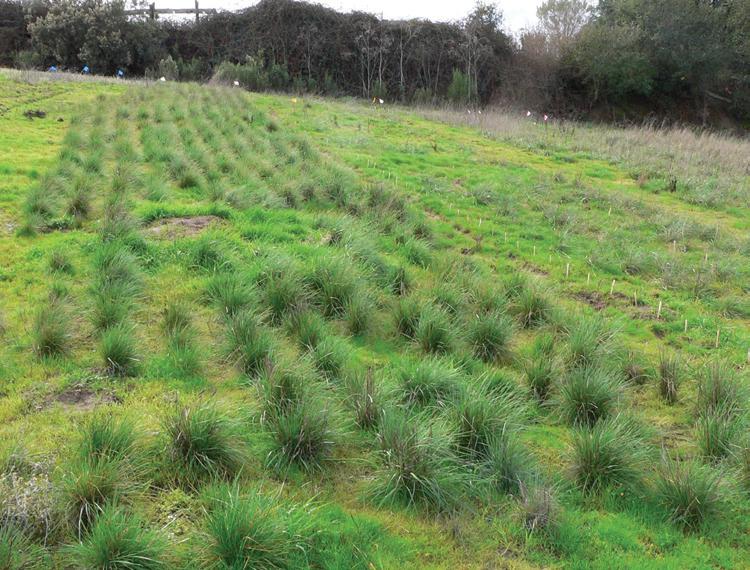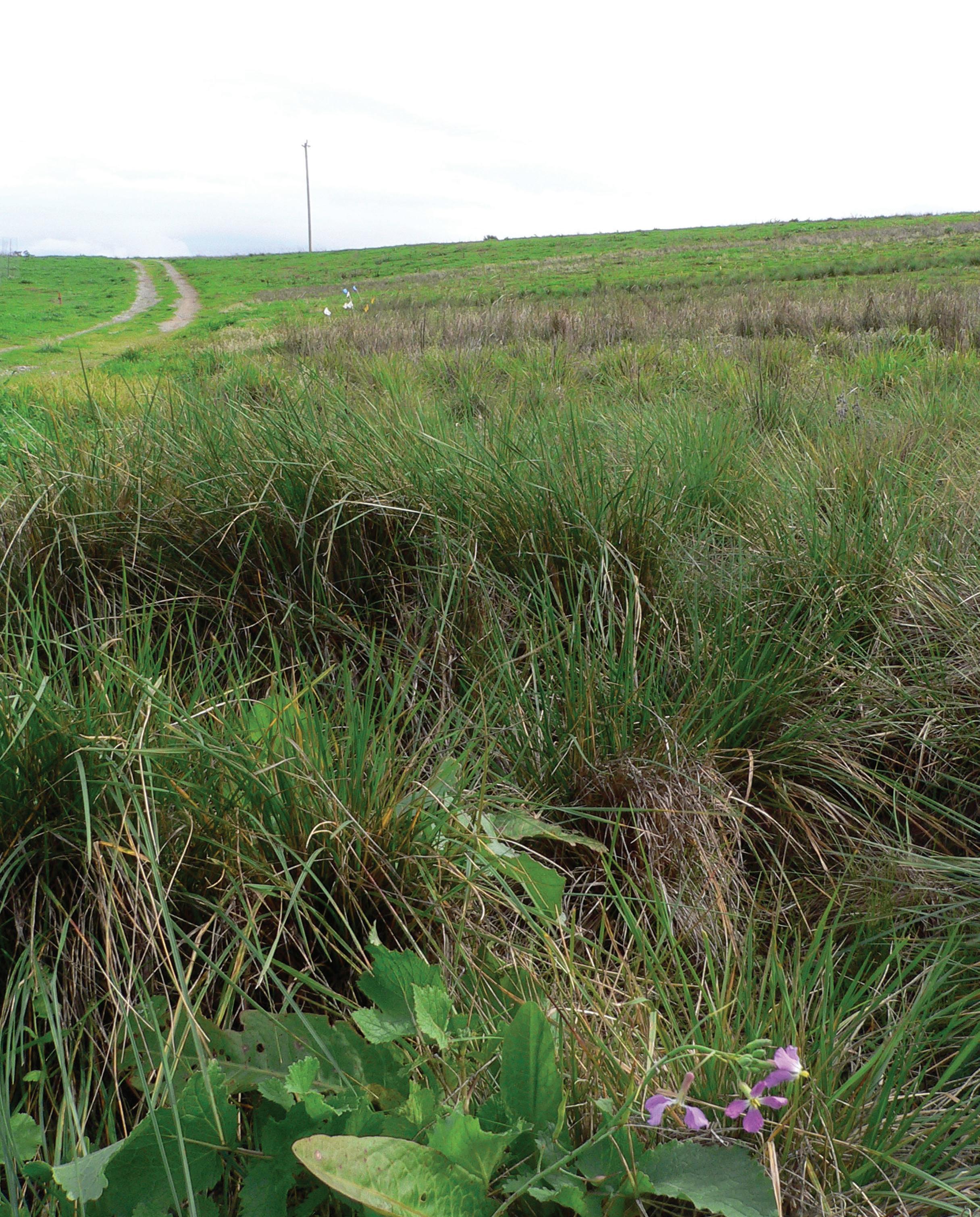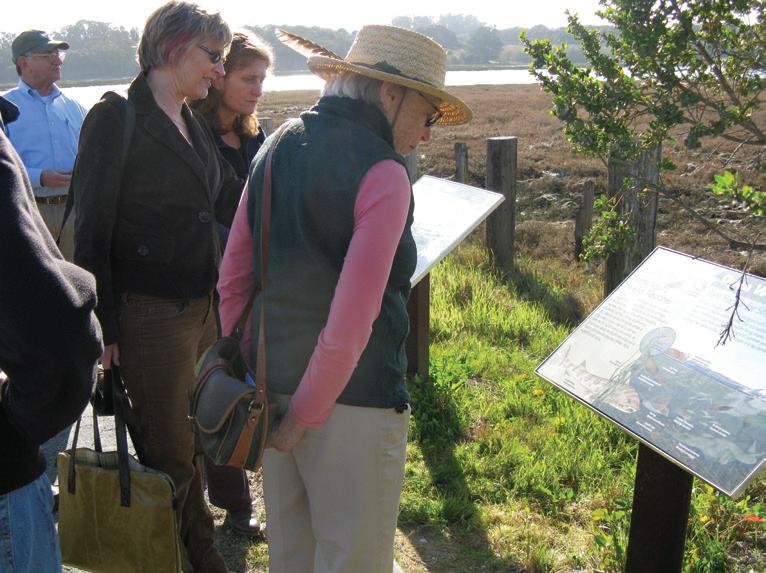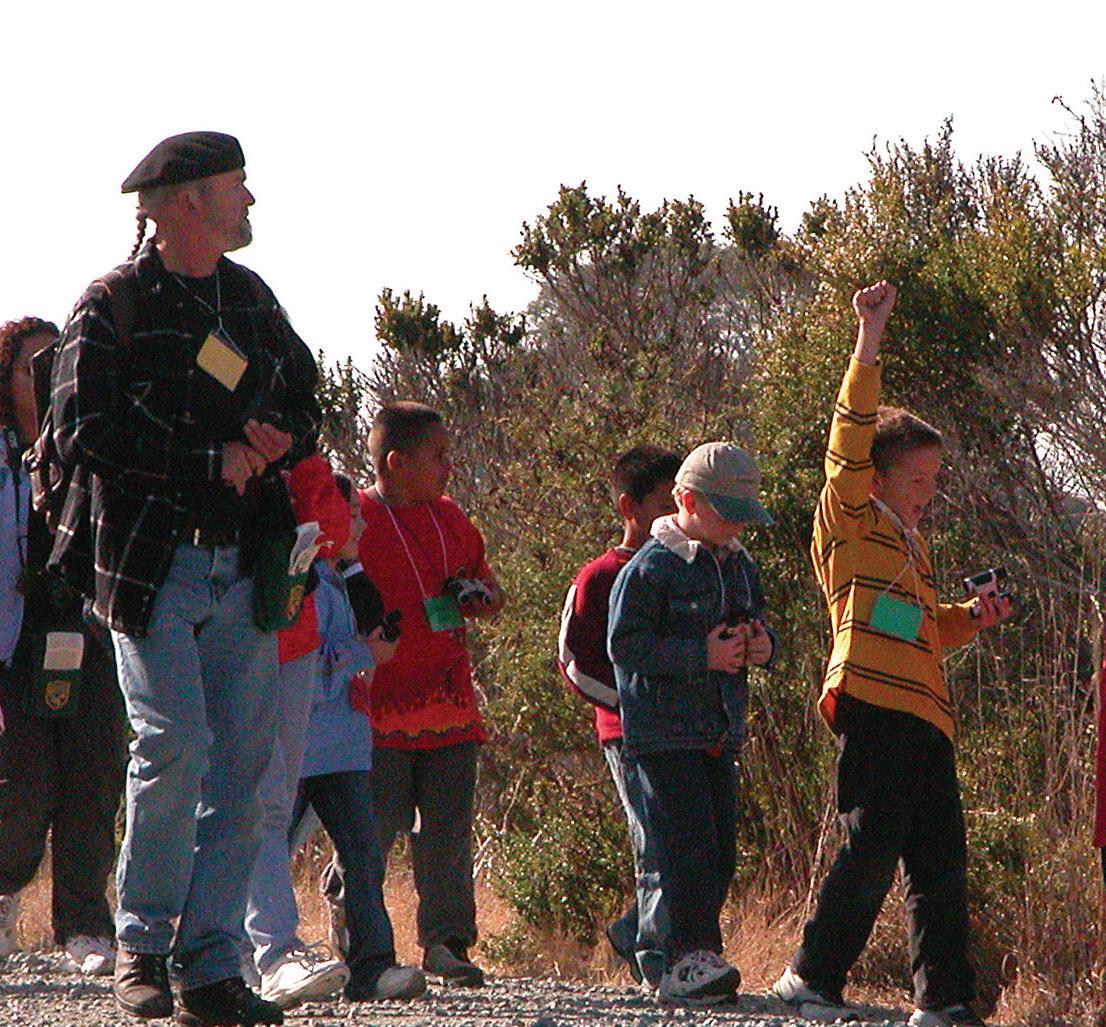

Tidal Exchange

History Tells the Story of Changing Tides
History Tells the Story of Changing Tides
The construction of the Parsons Slough sill is complete. The sill, an outcome of the Tidal Wetland Project, is essentially an underwater retaining wall built to slow the ebb tide currents that are responsible for eroding slough marshes—a solution for the vexing problem of scouring currents that have increased erosion in recent years. This effort was led by the Elkhorn Slough National Estuarine Research Reserve and supported by the Elkhorn Slough Foundation. More than 100 scientists, managers and conservationists met over a six-year span to study, understand and design a solution for the habitat changes caused by increased erosion. By examining evidence from the slough’s past, the Tidal Wetland Project was able to create a solution to preserve the slough’s future.
The lower reaches (nearest the harbor) of the slough have always been more influenced by the bay than the upper reaches. Now the
slough’s lower reaches have become more marine, or ocean influenced, and the extent of this influence is moving inland as the slough bed deepens. The erosion of the slough’s marshes and mudflats that causes this deepening has its roots in the modification of its hydrology over the span of the past 140 years.
There are many influences that lead to this change. The building of the Southern Pacific Rail line through the slough’s eastern wetlands in 1872, the diversion of the Salinas River, the diking of marshes for grazing and cultivation, the creation of Moss Landing Harbor, and the subsequent breaching of aging dikes and levees have all changed the way water flows through the slough dramatically. All these modifications contributed to marsh loss. First, the reduction in river-borne sediments, previously supplied by the Salinas River before it was diverted, has resulted in ‘starving’ the marshes of substrate. As sea
level rises, salt marsh plants usually trap suspended sediments and grow upward to stay above the mid-tide line. Without a steady supply of sediment, the plants will be submerged for longer periods of time and eventually ‘drown’. Second, the increase in the speed of ebb tide currents flowing out of the slough into the bay has eroded marshes along the main channel, sweeping marsh sediments into the bay and the Monterey Bay Submarine Canyon.
Land use changes have also contributed to an altered hydrology in the slough. In Parsons Slough— the southeast corner of Elkhorn Slough—more than 450 acres of salt marsh were diked, drained and converted to pasture land and farm use. As the marsh soils dried, they were compacted and subsided, or sank, up to five feet below their historic level. In the early 1980s the levees were broken, and the water that rushed in drowned the marsh plants that had
Newsletter of the Elkhorn Slough Foundation
Elkhorn Slough Foundation
Board of Directors
Steve Webster
President
Steve Dennis
Vice President
Richard Hammond
Treasurer
Steve Green
Secretary
Judith Connor
Terry Eckhardt
Bill Eggleston
Richard Nutter
Anne Secker
Lydia Villarreal
Tom Williams
Mary Wright
Staff
Mark Silberstein Executive Director
Kate Raymundo Administrative Director
Kim Hayes Stewardship Director
Ken Collins
Land Steward
John Kenney Farmland Manager
Kevin Contreras
Land Acquisition Specialist
Gabriele Estill Grants Manager
Lorili Toth Director of Development & Communications
Quinn Labadie Development & Communications Manager
Jessica Perri Office Manager
PO Box 267, Moss Landing California 95039
Tel: (831) 728-5939
Fax: (831) 728-7031 www.elkhornslough.org
Tidal Exchange
Editor:
Quinn Labadie
previously lived much higher up on the land. This drowning of plants that once held soil in place, combined with the extra five feet of water moving in and out of the slough, increased the volume of water moving through the slough and served to incrementally increase the speed of ebbing currents, increasing again the rate of marsh erosion.

The Parsons Slough sill will return tidal flows to a more natural rate and reduce the loss of marsh and fine sediments. This will conserve the threatened habitats that play such a major role of Elkhorn Slough.
The construction of the underwater sill at Parsons Slough has been a major undertaking. The project has been led by Bryan Largay, Director of the Tidal Wetland Project at the Reserve and a team of dedicated staff who have managed the complex aspects of marine construction. The Tidal Wetland Project’s Strategic Planning Team and Science Panel focused on Parsons Slough both as a place to significantly reduce the erosive currents and as a ‘test case’ for any potential future, larger-scale projects. The work was well reviewed – it required obtaining 14 permits from state, federal and local agencies. “This has been an extraordinary undertaking,” said Largay, “with enthusiastic cooperation from many partners, agencies, scientists and conservationists. We are very pleased that the construction has gone so smoothly and we’re excited about the benefits of this project to the long-term health of this remarkable place.”
The Parsons Slough Project was made possible by planning grants from the David & Lucile Packard Foundation and the Resources Legacy Foundation Fund. The American Recovery and Reinvestment Act funded its construction. In addition to conserving exceptional natural resources, this project is preserving or creating over 130 jobs – a key goal of the Recovery and Reinvestment Act. In addition to the Parsons Slough Sill, the project will be adding more than $120,000 of improvements to the Moss Landing Harbor District’s Kirby Park access.

Although construction is completed, the research continues. Throughout the next several years staff will monitor the impact that the sill and its change on tidal flow makes on the wetlands and wildlife in the slough. This research will provide vast data for the Elkhorn Slough and estuaries everywhere.
The Parsons Slough project is truly a community effort. Local scientists, landowners and regulators have worked hand in hand to make the Elkhorn Slough an enduring place of inspiration, and the project itself directly improves community access to this shared space. For more information, visit www.elkhornslough.org/tidalwetlandproject
Photo by Ken Collins
Guiding Our Growth

Invasive jubata
Thepast year has been a good year for stewardship. Through dedicated planning—and with the help of many volunteers—2010 saw leaps in progress for our watershed’s woodlands, grasslands, and more.
For 2010, the focus of our stewardship team’s restoration efforts was controlling jubata grass. Formerly known as pampas grass, this invasive plant is notoriously difficult to eradicate and highly aggressive. Left untreated it crowds out native grasses to create a monoculture as far as the wind will carry it.
Thanks to efforts from the stewardship team, thousands of hours have been spent removing jubata from upwind lands. By focusing on infestations in these places, the Stewardship Program has reduced the plant’s ability to spread by wind. By taking advantage of prevailing winds and working collaboratively with landowners, we have removed more than 200 acres of this exotic plant from over 2,000 acres of ESF land. This incredible progress would not be possible if it weren’t for a grant of $27,000 that was received from the US Fish and Wildlife Service and the Department of Agriculture through the Resource Defense Council of Monterey County.
Removing jubata has made room in the watershed for native grasses to thrive. ESF and Reserve stewardship
staff have been working to increase native grass seed by cultivating a “native grass farm.” The crop is native grass seed, a precious commodity in habitat restoration circles that will help ESF meet its goal of increasing native grasses in the farm buffer. This farm can be seen from Elkhorn Road, on the Foundation’s recently acquired Iniguez property.

Just up the hill from the Foundation’s already-established native grass rows are almost 3,000 new grass plantings, propagated, planted and maintained this year by staff and volunteers. Staff is growing blue wild rye, purple needle grass, tufted hairgrass, California meadow barley and California oat grass. The first harvest of grass seeds occurred this summer, and harvests will continue for years to come.

Founded in 1982, Elkhorn Slough Foundation is a community-supported 501(c) (3) nonprofit whose mission is to conserve and restore Elkhorn Slough and its watershed.
Members support these activities.
The Foundation has spearheaded innovative and cutting-edge research, conservation and educational programs in Elkhorn Slough. The Foundation now owns and/or manages nearly 4,000 acres — the largest conservation holdings in the Elkhorn watershed.
Since its inception, the Foundation has been directly involved in the restoration of over 1,000 acres of key habitats, including tidal wetlands, coastal prairie, oak woodlands, freshwater ponds, riparian corridors and maritime chaparral.
A board of directors, composed of conservationists, attorneys, educators, farmers, academics, business people, scientists and community volunteers, governs the Foundation.
Elkhorn Slough Foundation is a member of the national Land Trust Alliance and adheres to its recommended standards and practices. For more information, please visit www.landtrustalliance.org.
Native Grass Farm
The work of stewardship staff and volunteers has also benefitted greatly from the greenhouse—the work done there has led to approximately 18,200 seeds being sown, 4,000 seedlings being transplanted, and nearly 6,000 placed into restoration sites around the Reserve. This would not be possible if not for the donations from ESF members and volunteers who spent hundreds of hours spent cleaning and transplanting seeds and seedlings.

Among those volunteers were students from Vanderbilt University in Tennessee, who came to the slough for Alternative Spring Break—a program that partners students with meaningful community projects. They worked with Elkhorn Slough staff on a number of projects, including weeding at our native grass farm, planting lupines near a tidal wetland restoration site, greenhouse work ,and a fence-removal project. The students are
Kirby Park Ribbon Cutting
planning to return in 2011. The foundation also got a helping hand from Prunedale’s Boy Scout Troop 275, who [planted oak trees on the Iniguez property. This work connects students to their community and helps foster an understanding of natural processes like erosion and plant growth.
The stewardship team depends on volunteers to accomplish so much. In addition to the greenhouse work and jubata removal, volunteers have worked at various oak woodland sites and removed pounds of invasive species such as periwinkle and cape ivy. The ESF and Reserve stewardship team are thankful for this assistance. All volunteer help is welcome, and there is always more that needs to be done.

What ties the open water to the mud in the slough? How does salt marsh fit into the picture? Where can I see Long-billed curlews?
If you are like many visitors to the slough, you aren’t just enthralled by the beauty here--you want to learn more about the world around you! Which is why ESF has just unveiled new, beautiful interpretive signs at Kirby Park, funded by a grant from the Monterey Bay Aquarium Action Fund and developed by ESF Stewardship Director Kim Hayes along with ESNERR Research Coordinator Kerstin Wasson and DFG Education Coordinator Kenton Parker. Kirby Park was the natural choice to feature this kind of information: it has the only wheelchairaccessible trail along the shore, access to the water, and is free for all visitors seven days a week.



The new signs have stunning hand-drawn illustrations by Wildways Illustrated and describe the different types of habitats along the slough, which species live where, and notes about their behavior. There is something of interest for all ages, in both English and Spanish. The new signs are sure to give a unique insight to the slough around you.
Vanderbilt students plant lupines
Greenhouse
MeMber Spotlight: Anne Secker

Anne Secker is the newest member on the Elkhorn Slough Foundation’s Board of Directors. Anne is a lawyer at Noland, Hamerly, Etienne & Hoss, a Salinasbased law office. We are pleased to share this introductory chat so that we can all get to know Anne a bit better.
What kind of law do you practice? Mostly commercial law: anything from real estate and construction to leasing, land, and commercial contract matters. Generally a contract or agreement of some sort needs to be involved.
Where did you live before you moved to California, and what made you decide to move here? I grew up in Illinois and attended the University of Illinois College of Law. I moved to Monterey Bay because my husband said it was the most beautiful place on earth after living here while serving in the army at the Defense Language Institute, and that he wanted to live out the rest of his days in Monterey Bay. We both moved here after I graduated from law school. We travel a lot and have seen many, many places in the world, and he was right—it is the most beautiful place. I love to call this place home and I’m always happy to come back to it.
What do you do you and your husband do when you visit the slough? Where is your favorite place to hike? We are walkers and love to hike and see different areas during different seasons—each part of the slough is different every season. We really like to bird watch, although we’re not technical bird watchers and don’t know the names of each bird. We also kayak and have learned over the years to use the tide charts to time our trips to the slough. In the early days we didn’t realize how strong the current can get when you paddle against the wind and waves.
It’s such a different experience to see the slough from the water—you can get really close to some amazing things in a way you can’t when walking. The seal and otter activity is fascinating, and there is also interesting stuff in the water.
Why did you want to join the Elkhorn Slough Foundation Board of Directors? I’ve done legal work for the Foundation and was uniformly impressed by the Foundation’s goals and staff. I was impressed by how it works with agricultural neighbors and land owners to do what is best for the slough; I also like the creative way the Foundation thinks about things to reach the ultimate goal of preserving the slough.
What ESF work do you most value—what will you push for in 2011? I am still pretty new to the board so I’m still learning all of the different things the Foundation does. Of the things I know they do, I like their land trust work to preserve the slough, and their collaboration with scientists and neighbors.
What made you join ESF as a member? Because I had been out to the slough and seen it the restoration that was occurring as a result of ESF’s efforts, I decided to join ESF as a member. I thought it was an amazing place and thought that if I could be a part of it, even just as a financial supporter, it was worth doing because the slough caught my imagination.
Why should people value the Elkhorn Slough? It gives everyone something different, from a place to get away to a place to get exercise. It offers great for learning and family activities, too.
If you could tell someone just one thing about the slough, what would it be? Come out to the slough and experience the diversity of nature. Every time I come out I see and learn something different. You will get a sense of wonder about the world if you come and see what’s out there. It’s quiet, peaceful, and calm. Being there will help you get in touch with balance in life.
Anne also served on the Board of Directors of Ag Against Hunger, a local organization that distributes fresh fruit and vegetables to food banks and is a member the Planned Giving Committee for California State University, Monterey Bay. We are pleased to welcome her to our Board of Directors.

Protection is Forever: The Elkhorn Slough Foundation Strategic Initiative

As the single largest landowner in the watershed, the Elkhorn Slough Foundation takes great pride in our dedication to protect the watershed forever, and that is why our commitment to the land, our neighbors, and the community is made so plain in everything that we do as a land trust. ESF’s goal to protect and manage land impacting the Elkhorn Slough has led to great improvements in water quality, habitat diversity, and community involvement in the watershed.
The Foundation is proud that in the face of the economic downturn we have met the goals of our previous Strategic Initiative: since 2006 we have obtained funding for land acquisition and stewardship, implemented best management practices on all of our farmlands, restored 450 acres of degraded land, eradicated 2,000 acres of invasive plants, and engaged the public through volunteer projects and special events. Building on these successes, the Elkhorn Slough Foundation intends to spend the next five years continuing to support the Reserve, expand the protection of Elkhorn Slough through land or easement purchase and restoration. To accomplish this we will focus on key parcels affecting the health and future of the Elkhorn Slough.
The Foundation’s latest Strategic Initiative for 2010 – 2015 has four vital programmatic objectives. These are:
• Conserve and protect key lands in the Elkhorn Slough Watershed.
• Manage these protected lands including working farms and ranches to conserve their natural resources and demonstrate successful conservation use.
• Support programs and activities at the Elkhorn Slough Reserve that are complementary with our mission.
• Disseminate conservation knowledge to engage the community and advance the value, purpose, and effectiveness of conservation.
To help us reach these goals we will strengthen our human resource capacity and increase our community support. This will enable effective management and the ability to raise the funds critically needed to meet the programmatic goals.
Our objectives are ambitious, but we believe they are achievable. We know that with the support of our members and the local community we will continue to support and care for this amazing place.
The Elkhorn Slough Foundation Strategic Initiative is posted on the web under Get Involved/Elkhorn Slough Foundation.
CHOICE: ENVIRONMENTAL PRINTING
For more than two years, we’ve made the decision to ensure that this newsletter is environmentally friendly. With each issue ESF saves the following resources by printing Tidal Exchange on paper made of 10% post-consumer waste fiber paper, as opposed to virgin-fiber paper:

Brown pelican

Slough View
We asked on facebook: What are your favorite native plants to grow?
“I love our native California Fuscia - really beautiful, great for pollinators in your yard.” - Tiffany Hernandez
“We planted some currant, sticky monkeyflower, California pipevine, and several salvia species in our garden this morning. Hopefully the rain will help them thrive!” - Grey Whale

Follow ESF on facebook! Visit: http://www.facebook.com/elkhornslough

Silberstein, ESF Executive Director
This past decade has seen the scope and pace of Elkhorn Slough Conservation take great strides forward. ESF has shepherded over three-dozen strategic land transactions to completion since the adoption of the Elkhorn Slough Watershed Conservation Plan in 1999, adding over 2,600 acres of key lands to the conservation holdings in the slough.
In previous newsletters, we’ve chronicled the long hard path of bringing some of our acquired properties from a state of serious degradation to one of ecological health and vitality. The Foundation has cleaned up historical damage to give many of these properties a second chance they may never have otherwise had.
For those of us staffing these efforts, the commitment, dedication and generous spirit of community volunteers who have ‘put their shoulder to the wheel’ of land conservation is humbling. We have worked side by side with our neighbors from far and wide—in some cases digging in the dirt, clearing weeds, and planting new seeds; in other cases repairing damaged structures, cleaning up litter and monitoring indicators of environmental health. And the hard work has paid off. We’ve kayaked the waters of the slough and watched as the populations of sea otters, harbor seals and sea lions have grown dramatically. We’ve worked with educators across all grade levels and curricula to host tens of thousands of young students on visits to this remarkable outdoor classroom. More than 40,000 students visit the slough each year. We’ve cemented partnerships with public agencies and community organizations by working together to safeguard the future of the diversity of life that calls Elkhorn Slough home. This holistic approach to watershed protection is precedent-setting in conservation circles. Ensuring safe and sound access to slough visitors is another ongoing effort at the Foundation, and we are cooperating with the Elkhorn Slough Reserve and The Nature Conservancy to maintain existing access points and, where possible, to create others.
Looking ahead, we see continued opportunities to work with local land owners on shared conservation goals. We are already making great strides in helping land owners keep a small ecological footprint in the watershed by sharing innovative land management practices. The Elkhorn Slough Foundation’s focus over the next several years will be on the transformation of the conserved landscape and securing long-term stewardship support in the form of endowments linked to the land. The role of conservation and land management in protecting precious water resources will rise as more pressure is put on fragile coastal aquifers.
Future newsletters will present perspectives on this work and progress. We are excited to continue working with you, our community of support, to protect, sustain, enjoy, and share this remarkable place, the Elkhorn Slough.

Mark
Sticky monkeyflower
Bullrush

Elkhorn Slough Foundation
P.O. Box 267
Moss Landing, CA 95039
Get Involved with Elkhorn Slough!

If you’re not yet a member of Elkhorn Slough Foundation, we hope you will join today. Your membership directly supports the conservation and restoration of one of California’s last great estuaries and the abundance of life centered here.
Member Benefits
Members receive a 10% discount at the Elkhorn Slough Bookstore located in the Reserve Visitor Center and invitations to ESF member events, including walks on our lands and kayak tours of the Slough. Members also receive a free annual subscription to Tidal Exchange. Join us!
There are many exciTing ways To geT involved wiTh elkhorn slough!
Lend your green thumb at Nursery Drop-In the 2nd Wednesday of each month (Call Bree at 831-728-2822 x305).
Attend our next volunteer training and become an expert on all things Elkhorn Slough (Call Amanda at 831-728-2822 x303).
Visit www.elkhornslough.org for a complete schedule of our member events.
Events Calendar
Elkhorn Slough National Estuarine Research Reserve & Visitor Center 1700 Elkhorn Road, Watsonville, CA (831) 728-2822
Open Wednesday–Sunday, 9:00 a.m.–5:00 p.m.
Early Bird Tours First Saturday each month, 8:30 a.m.
Join expert Rick Fournier for early birding. Meet at the Visitor Center; $2.50 day-use fee.
Docent-led Tours of the Reserve Saturdays & Sundays 10:00 a.m. & 1:00 p.m. Tours meet rain or shine at the Visitor Center; $2.50 day-use fee.
Member Event: Spring birding walk Saturday, March 12.
ESF/ESNERR Native Plant Fair: Saturday, March 19.
Member Event: Magnifying the Slough Friday, March 25.
Stewardship Circle Event: Frog Safari Friday, April 15.
New Member Event: Sunset Walk Wednesday, April 20.
